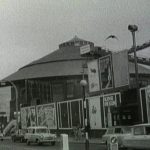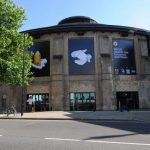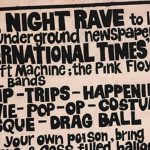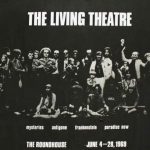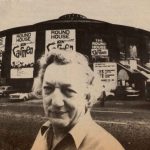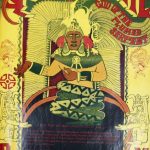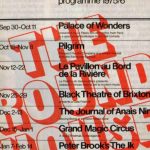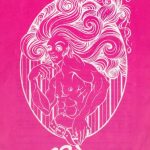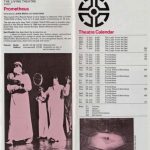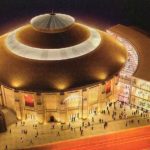Venue name: The Round House.
During the years 1966-1982 the name of the venue was usually written as two separate words in publicity material. Later schemes and the current brand name use a single word i.e. The Roundhouse
Location: Chalk Farm Road, London.
Established: The building was a Victorian engine shed and began to be used as a music and theatre venue from 1966
Founders, executives and directors: Arnold Wesker (1966-1970); George Hoskins (1966-1977); Thelma Holt (1977-1983); Torquil Norman (1996-2007) and Marcus Davey (from 1999)
Current status: Still operating
History:
Centre 42 and the Counter-Culture
In 1966, after years of campaigning, Arnold Wesker’s visionary scheme to create an arts centre – Centre 42 – for ‘the people’ and partially funded by the Trade Union movement had progressed sufficiently for the Trust to have obtained the freehold of an enormous 120 year old engine shed in Chalk Farm. In order to make the building safe and to develop it as a multipurpose performance space, businessman George Hoskins was brought in as fundraiser and financial adviser. From the outset Wesker and Hoskins were in conflict – Wesker had an ‘all or nothing’ approach to the fundraising whilst Hoskins wanted to see fund-generating events start immediately and thereby enable piecemeal improvements. Hoskins’s ‘open door’ policy with regards to the renting out the venue soon established the Round House as the centre of the UK’s emerging counter-culture scene. As early as October 1966 the Round House hosted a Soft Machine and Pink Floyd benefit concert for the newly established underground newspaper International Times. In the Spring of 1967 there were regular rock concerts – The Doors, Jimi Hendrix and The Who all played there and the venue hosted the UFO Club (following the closure of UFO’s Tottenham Court Road premises) and later Middle Earth. In July 1967 Dialectics of Liberation was a landmark conference featuring speakers such as: Allen Ginsberg; Stokely Carmichael; Angela Davis and R.D.Laing. 1968 also saw the start of regular theatre performances with Peter Brook’s Themes on The Tempest.
International Theatre Companies and Rock Musicals
The dramatic in-the-round performance space was ideally suited to experimental work such as that of Peter Brook, The Living Theatre’s Paradise Now and Frankenstein, Berkoff’s Metamorphosis and Freehold’s Antigone (all in 1969). More traditional productions such as Contemporary Theatre’s This Foreign Field (Alan Sillitoe) and Wesker’s own The Friends failed to connect with audiences in the cavernous auditorium and its problematic acoustic. When George Hoskins followed the financially disastrous The Friends with Kenneth Tynan’s controversial sex revue Oh! Calcutta! – that ran for eight weeks – Arnold Wesker resigned from the Round House board. Hoskins greatest success the 1970s was in bringing large scale experimental international companies to London such as Jerome Savary’s Le Grand Magic Circus (1972,1974 & 1975) , Chaikin’s Open Theatre (1973), Stomu Yamas’tas Red Budda Theatre (1973 & 1975) and Frantz Salieri’s La Grande Eugene (1976). Despite these remarkable highlights and home-grown successes such as Joint Stock’s Epsom Downs (1977) and Lindsay Kemp’s Flowers and Salome, Hoskins’s ‘open door’ policy produced very uneven artistic quality. The venue had a notoriety that arose partly from some high-profile controversial shows and also from fairly overt drug-dealing and drug-use at rock concerts. The venue was also associated with a series of commercial rock musicals such as Catch My Soul, Godspell, Rock Carmen and Joseph and His Amazing Technicolour Dream Coat – all transferring to commercial theatres in the west-end. In 1975 a small studio space – Theatre Downstairs – opened to take small scale touring companies.
Thelma Holt
In 1977 George Hoskins became ill and Thelma Holt – who had just left the Open Space Theatre – took over the running of the theatre. Holt’s vision for the theatre was to drop the Sunday night rock concerts, apply more rigorous artistic standards and create a London home for the best of regional and international theatre. Inspired by Manchester’s Royal Exchange Theatre – that also inhabited a Victorian building – she headed a fundraising campaign to revamp the space. The new auditorium, almost an exact copy of the Royal Exchange, had a reduced seating capacity (from 940 -600) but was more suited to a variety of theatrical presentation. The first three productions in the newly configured space in 1979 were from Manchester and included Vanessa Redgrave in Ibsen’s The Lady From the Sea. In the longer term a permanent relationship with Manchester Royal Exchange failed to stick. The Sheffield Crucible and Alan Ayckbourn’s Scarborough company were further examples of regional theatre’s work being presented in London and Holt continued the policy of bringing in international companies. Despite a continuingly interesting programme, the theatre couldn’t operate financially without public subsidy and in 1982 the Arts Council withdrew financial backing on the grounds that the venue did not receive financial backing from its local authority, Camden Council. The building closed as a performing venue in 1983.
After Twenty Three Years Dark the Roundhouse Re-opens!
London Borough of Camden and the former GLC bought the building in 1983 with plans to turn it into a Black arts centre – but the project was mismanaged and eventually in 1988 the project was abandoned. The building now changed hands a number of times – it was to be a sports and arts arena and later a British Architectural Library for RIBA. It wasn’t until 1996 when Torquil Norman, the Bluebird Toy millionaire and philanthropist, got involved and with the intention of creating a performing arts centre for young people the reopening of The Roundhouse was a possibility. Marcus Davey was appointed Executive Director in 1999 and following extensive fund-raising, building work commenced eventually in 2004. In June 2006 with a £30m refurbishment, the new Roundhouse opened its doors once again! The performing arts centre is supported by a programme of music concerts and theatre and circus related spectacles. The Argentinean aerial company, De La Guarda presented the opening show Fuerzabruta in the main auditorium. The small studio theatre’s name- Studio 42 – harks back to Arnold Wesker’s legacy. In January 2007 Torqui Norman stepped down from being Chairman of the Roundhouse Trust after ten years working on the project.
Gallery:
Interviewee reference: David Cleall, Paddy Fletcher
Existing archival material: Round House Archive at V & A Theatre Archive. A file of newspaper cuttings is available at the Unfinished Histories archive at the Bishopsgate Institute
Links: The Roundhouse celebrates 50 years
Dialectics of Liberation conference
The current Roundhouse home page
Bibliography: The Roundhouse Chalk Farm Road, NW1 Neil Lyndon Time Out August 1972
All Dressed Up Jonathon Green (Pimlico,1999)
Off-centre Stages – Fringe theatre at the Open Space and the Round House 1968-1983 by Jinnie Schiele (includes a chronology of theatre productions presented at The Round House). Published by University of Hertfordshire Press, 2005. This book is available for reference only at Unfinished Histories Archive at Bishopsgate Institution.
Acknowledgements: This page was written by David Cleall

